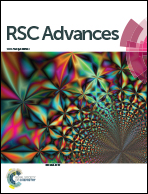Morphology-controllable synthesis of carbon nanomaterials directly on Al2O3 substrates, and their photoluminescence
Abstract
By controlling the growth temperature, different categories of carbon nanomaterials (CNMs) such as carbon nanocoils (CNCs) and chain-like carbon nanospheres (CNSs) can be synthesized directly over Al2O3 substrate without using any transition-metal catalysts. It is proposed that the Al2O3 particles play a key role in the CNM growth, and the reaction temperature has a great impact on the morphology of the obtained CNMs. Furthermore, the photoluminescence studies indicate that the obtained CNCs and chain-like CNSs show different optical properties, which suggest that the optical properties of the obtained CNMs may be tuned by controlling their structures.


 Please wait while we load your content...
Please wait while we load your content...